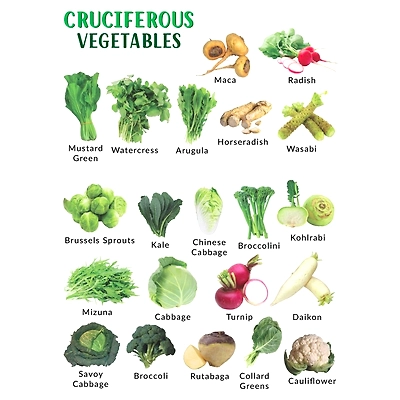Cruciferous Vegetables
0.38
0.40
You Save: 0.02. Discount: 5%
-
Product is not available
Country Of Origin : India
Cruciferous vegetables belong to the Brassicaceae family and are known for their distinctively shaped, cross-shaped flowers. They are rich in nutrients and offer various health benefits. Here's a description and specifications for cruciferous vegetables:
- Broccoli
- Cauliflower
- Brussels Sprouts
- Cabbage
- Kale
- Bok Choy
Description:
- Appearance: Cruciferous vegetables encompass a diverse range of vegetables with unique shapes, colors, and textures. Examples include broccoli, cauliflower, Brussels sprouts, cabbage, kale, and bok choy.
- Texture: The texture of cruciferous vegetables can vary from crunchy and firm to tender and leafy, depending on the specific vegetable and how it's prepared. Some, like broccoli and cauliflower, have florets, while others, like kale and cabbage, have dense leaves.
- Flavor: Cruciferous vegetables have a distinctive flavor profile that ranges from mild and slightly sweet to peppery and bitter. The flavor intensifies when cooked, with some varieties developing a nutty or caramelized taste.
- Aroma: When raw, cruciferous vegetables have a fresh, slightly pungent aroma that is characteristic of the Brassica family. The aroma becomes more pronounced when they are cooked.
Specifications for Culinary Use:
- Cleaning: Cruciferous vegetables should be thoroughly washed under running water to remove any dirt, debris, or pesticides from the surface. It's essential to inspect them for any signs of wilting, discoloration, or damage.
- Preparation: Cruciferous vegetables can be eaten raw in salads or coleslaws, or cooked in a variety of dishes such as stir-fries, soups, stews, and roasts. They can be steamed, boiled, roasted, grilled, or sautéed.
- Cooking Time: Cooking times vary depending on the type of cruciferous vegetable and the desired texture. Some varieties, like Brussels sprouts and cauliflower, cook relatively quickly, while others, like kale and cabbage, benefit from longer cooking times to soften and develop their flavors.
- Flavor Pairings: Cruciferous vegetables pair well with a wide range of ingredients, including garlic, onions, ginger, citrus fruits, nuts, seeds, and herbs. They can be seasoned with spices, vinegars, soy sauce, and oils to enhance their flavor.
- Nutritional Value: Cruciferous vegetables are highly nutritious and are rich in vitamins, minerals, and antioxidants. They are an excellent source of vitamin C, vitamin K, folate, potassium, and fiber. Cruciferous vegetables also contain compounds called glucosinolates, which have been linked to various health benefits, including cancer prevention and heart health.
Storage:
- Cruciferous vegetables should be stored in the refrigerator to maintain their freshness and crispness. They can be stored in a plastic bag or container with a damp paper towel to prevent wilting.
- It's best to consume cruciferous vegetables within a few days of purchase to ensure optimal flavor and nutritional value. It's essential to discard any vegetables that show signs of spoilage or decay.



